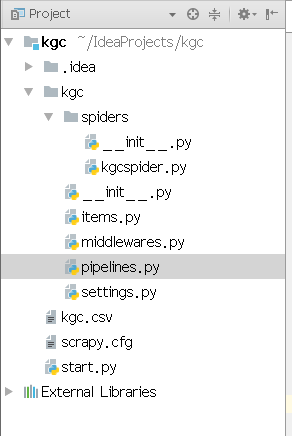上一篇博客已经讲述了对文本信息的爬取,本章将详细说一下对图片信息的爬取。
首先先看一下项目的目录:

老规矩,根据代码页进行讲解:(本次只针对一个页面进行讲解,多页面爬取只需解除注释即可)
kgcspider.py
# -*- coding: utf-8 -*- import scrapy from kgc.items import * class KgcspiderSpider(scrapy.Spider): name = 'kgcspider' #allowed_domains = ['http://www.kgc.cn/list/230-1-6-9-9-0.shtml'] start_urls = ['http://www.kgc.cn/list/230-1-6-9-9-0.shtml'] def parse(self, response): #print(response.body.decode()) title = response.css('a.yui3-u.course-title-a.ellipsis::text').extract() price=response.css('div.right.align-right>span::text').extract() persons=response.css('span.course-pepo::text').extract() image_urls=response.css('a.kgc-w>img::attr("src")').extract() #print(title) datas=zip(title,price,persons,image_urls) for d in datas: item=KgcItem() item['title']=d[0] item['price']=d[1] item['persons']=d[2] item['image_urls']=[d[3]] yield item # next_url=response.css('li.next>a::attr("href")').extract_first() # # if next_url is not None: # yield response.follow(next_url,self.parse)
精解:对于之前的文本内容的爬取代码保持不变,增加的图片的爬取路径image_urls,也对其进行循环输出,并且放到item中。
item.py
import scrapy class KgcItem(scrapy.Item): # define the fields for your item here like: # name = scrapy.Field() title=scrapy.Field() price=scrapy.Field() persons=scrapy.Field() image_urls=scrapy.Field() images=scrapy.Field()
精解:在实体类item中,加入存储的field,并且对图片images进行存取。images存储的时图片的一些存储路径path,爬取路径URL等,后期可以根据path查询图片。
piplines.py
class KgcPipeline(object): def open_spider(self,spider): #当蜘蛛启动时自动执行 self.file=open("/home/yzhl/IdeaProjects/kgc/kgc.csv","w",encoding='utf8') def process_item(self, item, spider): #蜘蛛每yild一个item,执行一次 line=item["title"]+","+item["price"]+','+item["persons"]+','+item["images_urls"]+' ' self.file.write(line) return item def close_spider(self,spider): #蜘蛛完成工作关闭执行 self.file.close()
精解:当启动蜘蛛后,这个kgc.csv文件的类型已经不再适用,item.py只对其执行yield的item,所以就需要对setting文件进行配置了。
setting.py
ITEM_PIPELINES = { 'kgc.pipelines.KgcPipeline': 300, 'scrapy.pipelines.images.ImagesPipeline': 1, } IMAGES_STORE='/home/yzhl/kgcimages'
精解:在intem_pipelines中加入scrapy关于图片images的管道,同时还要在实体类item中写入关于store的路径,路径即存储图片的文件夹的路径,这样下载的图片就会依次存入到文件夹的目录下。
路径获取:cd到当前目录下,pwd查找当前路径。